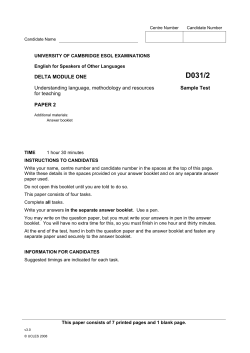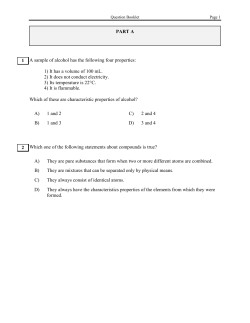
Sample Lessons 12, 47 & 70
Sample Lessons 12, 47 & 70 Understanding Minds Press PO Box 501, Mermaid Beach, Queensland 4218 Phone 07 55261516 Fax 07 55751069 Email info@understandingminds.com.au Copyright © Craig Wright ISBN 978-0-9871568-0-8 All rights reserved. The purchasing individual or organisation has entered into a site licence agreement with the publisher. The site licence entitles the purchaser to use the product in a single location. No part of this publication may be reproduced, stored in a retrieval system or transmitted in any way or by any means, electronic, mechanical, photocopying, recording or otherwise, without prior written permission of the author. If purchased for home use, the purchaser is prohibited from transmitting the product to another home or school by any means without prior written permission of the author. If purchased for a school, the purchaser is prohibited from transmitting the product to another school site or clinic by any means without prior written permission of the author. Schools are prohibited from transmitting the product to parents. If purchased for a clinic or tutoring organisation, the site licence entitles the purchaser to use the product at a single site. Purchasers are prohibited from copying any part of the product for use at any other site, regardless of whether other sites are part of the same business. They are prohibited from copying the product for use by clients outside of the setting for which the site licence was purchased. Requests to the author should be addressed to Understanding Minds, Suite 5, 2460 Gold Coast Highway, Mermaid Beach Qld, 4218 Australia or emailed to info@understandingminds.com.au. © Dr. Craig Wright 2014 | Understanding Words ® | Reading Accuracy Foundations | SAMPLE LESSONS 12, 47, 70 2 Lesson 12 A. Word-reading Materials: Teacher & Student Booklets 1. If you know a word; just say it. If you don’t know a word, look carefully, decode it slowly in your head, and say it quickly when I give the signal. 2. Look at your book. First word. Wait several seconds to allow those students who have to decode the chance to do so and then give an auditory signal for the group to name the whole word quickly. 3. Next word. Signal. D. Sentence reading Materials: Teacher & Student Booklets 1. You are going to read some sentences. The words that can’t be sounded out are written in red. What do we know about words that are written in red? (They can’t be sounded out) Repeat until firm. If a word can’t be sounded out, what colour will it be written in? (Red) Repeat until firm. 2. (Name), first sentence. Remember: if you know the word, just say it. If you don’t know it, look carefully and sound it out. 3. (Name), next sentence. B. Phoneme segmentation & word-spelling Materials: Teacher Booklet, mini-whiteboards 1. Say spit. Repeat until firm. Say it slowly. (/s/ /p/ /i/ /t/) Repeat until firm. Now write it. 2. Repeat procedure for spin, snap and pip. C. Irregular words Materials: Teacher Booklet, Sight Word List 1 1. Next rule. Some words can’t be sounded out. Say the rule. Repeat until firm. 2. Present words in List 1 in random order until all students can correctly name all the words. TEACHER PROMPTS Student tries to decode an irregular word Remember that words written in red can’t be sounded out/decoded. What word? If the student can’t name the word: That word is was. What word? Now go back to the start of the sentence and re-read. Letter-sound error Point to letter. This letter makes /i/. What sound? Now try again. Say it slowly as I point to the letters, then say it quickly. Blending error I like the way you looked carefully and said the letter sounds. Listen as I say it slowly and you tell me what the whole word is: /t/ /i/ /n/. Correct response: Yes, tin. Incorrect response: Repeat until correct. © Dr. Craig Wright 2014 | Understanding Words ® | Reading Accuracy Foundations | SAMPLE LESSONS 12, 47, 70 3 E. Letter-sound recognition Materials: Teacher Booklet, whiteboard 1. Next rule. Write d on the whiteboard. 2. Point to d. This letter makes the sound /d/. What sound? Repeat until firm. 3. Write d on a different part of the whiteboard. What sound? Repeat until firm. F. Sound writing Materials: Teacher Booklet, mini-whiteboards 1. Say dog. Repeat until firm. What’s the first sound in dog? (/d/) Repeat until firm. Write the letter that makes /d/. 2. Repeat procedure for seat, deep, nap, dot and dip. G. Sound cards Materials: Teacher Booklet, sound cards: d, n, i, s, p, a, t 1. Present sounds cards in random order. As you show each card ask: What sound? 2. Continue task until all students have mastery. H. Phoneme identification & sound spelling Materials: Teacher Booklet, mini-whiteboards I. Spelling Materials: Teacher Booklet, whiteboard, mini whiteboards for students 1. Write and on the whiteboard. 2. What word? Repeat until firm. 3. Write and on your board. 4. Watch as I make and into sand. Add s to sand. Point. What word? Repeat until firm. 5. Make and into sand on your board. 6. Continue procedure, having students change sand-and-an-tan-dan-din-dip-sip-sin-sip-snipsnap. J. Word-reading Materials: Teacher & Student Booklets 1. If you know a word; just say it. If you don’t know a word, look carefully, decode it slowly in your head, and say it quickly when I give the signal. 2. Look at your book. First word. Wait several seconds to allow those students who have to decode the chance to do so and then give an auditory signal for the group to name the whole word quickly. 3. Next word. Signal. K. Sentence reading Materials: Teacher & Student Booklets 1. Let’s work on end sounds. 2. Say mad. Repeat until firm. What’s the end sound in mad? (/d/) Repeat until firm. Write the letter that makes /d/. 3. Next. Say meet. Repeat until firm. End sound? (/t/) Repeat until firm. Write the letter that makes /t/. 4. Repeat procedure for sad, snap, mid, eat and cord. 1. You are going to read some sentences. The words that can’t be sounded out are written in red. What do we know about words that are written in red? (They can’t be sounded out) Repeat until firm. If a word can’t be sounded out, what colour will it be written in? (Red) Repeat until firm. 2. (Name), first sentence. Remember: if you know the word, just say it. If you don’t know it, look carefully and sound it out. 3. (Name), next sentence. © Dr. Craig Wright 2014 | Understanding Words ® | Reading Accuracy Foundations | SAMPLE LESSONS 12, 47, 70 4 TEACHER PROMPTS Student tries to decode an irregular word Remember that words written in red can’t be sounded out/decoded. What word. If the student can’t name the word: That word is was. What word? Now go back to the start of the sentence and re-read. Letter-sound error Point to letter. This letter makes /i/. What sound? Now try again. Say it slowly as I point to the letters, then say it quickly. Blending error I like the way you looked carefully and said the letter sounds. Listen as I say it slowly and you tell me what the whole word is: /t/ /i/ /n/. Correct response: Yes, tin. Incorrect response: Repeat until correct. L. Word-reading Materials: Teacher Booklet, whiteboard 1. Write sat on the whiteboard. 2. What word? Repeat until firm. 3. Change sat into pat. What word? Repeat until firm. 4. Continue procedure changing pat-pit-pin-sinsit-spit-spat-sat-nat-nit-pit-pin-pan-span-spatspit. ■■END OF LESSON 12 © Dr. Craig Wright 2014 | Understanding Words ® | Reading Accuracy Foundations | SAMPLE LESSONS 12, 47, 70 5 Lesson 47 A. Word-reading Materials: Teacher & Student Booklets 1. If you know a word; just say it. If you don’t know a word, look carefully, decode it slowly in your head, and say it quickly when I give the signal. 2. Look at your book. First word. Wait several seconds to allow those students who have to decode the chance to do so and then give an auditory signal for the group to name the whole word quickly. 3. Next word. Signal. B. Letter-sound recognition Materials: Teacher Booklet, whiteboard 1. Write ai on the whiteboard. What sound? Repeat until firm. 2. Write ay next to ai. This letter group also makes /ae/. What sound? Repeat until firm. 3. Write ay on a different part of the whiteboard. What sound? Repeat until firm. C. Sound cards Materials: Teacher Booklet, sound cards: ay, j, w, or, ou, ck, oa, ai 1. Present sounds cards in random order. As you show each card ask: What sound? 2. Continue task until all students have mastery. D. Phoneme segmentation & word-spelling Materials: Teacher Booklet, mini-whiteboards, whiteboard, 3 counters (or coins) for each student 1. Give each student three counters. Show me the first counter. Show me the middle counter. Show me the end counter. Repeat until firm. Check each student for mastery. 2. Write ai and ay on the whiteboard. What sound? 3. Here’s a spelling rule. 4. When /ae/ is the middle sound in a word we write the sound with a-i (use letter names). Say this: /ae/ in the middle; a-i. Repeat until firm. 5. Let’s use that rule. Say bait. Say it slowly. Repeat until firm. Is the /ae/ sound at the start, in the middle or at the end? (Middle). Now write it. Ask a student to explain why they selected ai. (Because the /ae/ was the middle sound). 6. Follow the same procedure for train and the nonwords sait and taif. 7. Listen. /ae/ in the middle; a-i (use letter names). Say that rule. Repeat until firm. 8. New rule. 9. When /ae/ is the end sound in a word we write the sound with a-y (use letter names). Say this: /ae/ on the end; a-y. Repeat until firm. 10. Let’s use that rule. Say day. Say it slowly. Repeat until firm. Is the /ae/ sound at the start, in the middle or at the end? (End). Now write it. Ask a student to explain why they selected ay. (Because the /ae/ was the end sound). © Dr. Craig Wright 2014 | Understanding Words ® | Reading Accuracy Foundations | SAMPLE LESSONS 12, 47, 70 6 11. Follow the same procedure for stay, play and way. 12. Listen to our rules. /ae/ in the middle; a-i. /ae/ at the end; a-y. Say the whole rule. Repeat until firm. E. Word-reading Materials: Teacher & Student Booklets 1. If you know a word; just say it. If you don’t know a word, look carefully, decode it slowly in your head, and say it quickly when I give the signal. 2. Look at your book. First word. Wait several seconds to allow those students who have to decode the chance to do so and then give an auditory signal for the group to name the whole word quickly. 3. Next word. Signal. F. Irregular words Materials: Teacher Booklet, Sight Word Lists 3-4, 6-7 H. Word-reading Materials: Teacher Booklet, whiteboard 1. Write rain on the whiteboard. 2. What word? Repeat until firm. 3. Change rain into main. What word? Repeat until firm. 4. Continue procedure changing main-moan-mainmaip-map-man-main-moan-joan-joab-job-cobcub-club-cloak-clock-claim-plain-plan-loandroan-dray-tray-train-main-moan-may-daystay-stout-bout-bor. I. Sentence reading Materials: Teacher & Student Booklets 1. You are going to read some sentences. The words that can’t be sounded out are written in red. 2. (Name), first sentence. Remember: if you know the word, just say it. If you don’t know it, look carefully and sound it out. 3. (Name), next sentence. 1. Present words in Lists 3-4, 6-7 in random order until all students can correctly name all the words. ■■END OF LESSON 47 G. Word-reading Materials: Teacher & Student Booklets 1. If you know a word; just say it. If you don’t know a word, look carefully, decode it slowly in your head, and say it quickly when I give the signal. 2. Look at your book. First word. Wait several seconds to allow those students who have to decode the chance to do so and then give an auditory signal for the group to name the whole word quickly. 3. Next word. Signal. © Dr. Craig Wright 2014 | Understanding Words ® | Reading Accuracy Foundations | SAMPLE LESSONS 12, 47, 70 7 Lesson 70 A. Word-reading Materials: Teacher & Student Booklets 1. If you know a word; just say it. If you don’t know a word, look carefully, decode it slowly in your head, and say it quickly when I give the signal. 2. Look at your book. First word. Wait several seconds to allow those students who have to decode the chance to do so and then give an auditory signal for the group to name the whole word quickly. 3. Next word. Signal B. Sentence reading Materials: Teacher & Student Booklets 1. You are going to read some sentences. The words that can’t be sounded out are written in red. 2. (Name), first sentence. Remember: if you know the word, just say it. If you don’t know it, look carefully and sound it out. D. Letter-sound recognition Materials: Teacher Booklet, whiteboard 1. Next rule. 1 Some letter groups make more than one sound. 2. Write oo on the whiteboard. What sound? (/ew/ as in soon) Repeat until firm. 3. Write oo on a different part of the whiteboard. This letter group also makes /oo/ (as in cook). What sound? Repeat until firm. 4. In the next activities oo (use letter names) always make /oo/ (as in cook). E. Phoneme segmentation & word-spelling Materials: Teacher Booklet, mini-whiteboards 1. Say cook. Repeat until firm. Say it slowly. Repeat until firm. Now write it. 2. Repeat procedure for looking, good, length and stood. 3. (Name), next sentence. F. Word-reading C. Irregular words Materials: Teacher Booklet, Sight Word Lists 7-10 1. Present words in Lists 7-10 in random order until all students can correctly name all the words. Materials: Teacher & Student Booklets 1. If you know a word; just say it. If you don’t know a word, look carefully, decode it slowly in your head, and say it quickly when I give the signal. 2. Look at your book. First word. Wait several seconds to allow those students who have to decode the chance to do so and 1.Note: The digraph oo can make two sounds (/oo/ as in look and /ew/ as in soon). The sound taught in this Lesson is /oo/ as in cook. © Dr. Craig Wright 2014 | Understanding Words ® | Reading Accuracy Foundations | SAMPLE LESSONS 12, 47, 70 8 then give an auditory signal for the group to name the whole word quickly. K. Nonword-spelling Materials: Teacher Booklet, mini-whiteboards 3. Next word. Signal. G. Irregular words Materials: Teacher Booklet, Sight Word List 11 1. Present words in List 11 one at a time. Introduce each one: This word is because. What word? 2. When all the words have been introduced, present cards in random order until all students can correctly name all the words in the list. 1. Say mook. Repeat until firm. Say it slowly. Repeat until firm. Now write it. 2. Repeat for quep, bength, doups, dapes2, and dooch. L. Nonword-reading Materials: Teacher & Student Booklets 1. These are made up words. H. Comprehension/Grammatical sensitivity Materials: Teacher & Student Booklets 2. First word. Look carefully, decode it slowly in your head, and say it quickly when I give the signal. Wait several seconds to allow students to decode and then give an auditory signal for the group to name the whole word quickly. 1. (Student’s name), read the first sentence. 2. (Student), read Question 1. 3. Follow the same procedure for the remaining questions and sentences. ■■END OF LESSON 70 I. Comprehension/Grammatical sensitivity Materials: Teacher & Student Booklets 1. (Student’s name), read the first sentence. 2. (Student), read Question 1. 3. Follow the same procedure for the remaining questions and sentences. J. Word-reading Materials: Teacher Booklet, whiteboard 1. Write rip on the whiteboard. 2. What word? Repeat until firm. 3. Change rip into ripe. What word? Repeat until firm. 4. Continue procedure changing ripe-rain-draindron-drone-drain-plain-pain-ping-sing-soonboon-boot-scoot-skate-fate-late-length-longstrong-strain-rain-roof-rook-cook-coke. 2. ‘daips’ is also acceptable. © Dr. Craig Wright 2014 | Understanding Words ® | Reading Accuracy Foundations | SAMPLE LESSONS 12, 47, 70 9
© Copyright 2025















